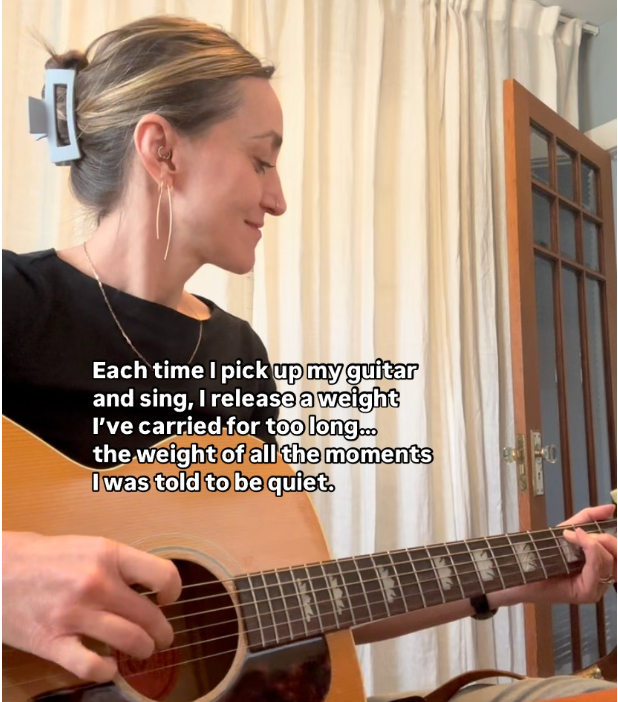
8 Ways to Embrace Your Voice & Cultivate Your Authentic Self-Expression (pt 1/2)
To be 'authentic' seems to be a buzz phrase that goes around.
But what does authenticity really mean?
Does it mean we should snap when we feel upset, or start balling when the cashier asks us how our day is going... probably not.
Authenticity is (in my humble opinion) a place of resonance. It happens when our body, heart, & mind are working together & we are able to express ourselves with self-awareness & personal (& external respect). This is, of course, a layered process... because self-understanding & communication evolves as we do. When we embrace our voice & experience as they are we simultaneously cultivate more steady & authentic self-expression.
So how can you Embrace Your Voice & Cultivate Your Authentic Self Expression?
1. Create a Sanctuary for Your Voice
One of the first challenges to self-expression & authenticity is having a clear idea of what we truly feel, desire, or want to move away from. This often occurs because we are so focused on how we might come across to others that we lose sight of what is true for ourselves. For example, if you find yourself ruminating about the would’ve, should’ve, could’ve… it’s probably a good time to go into your sanctuary.
A sanctuary of voice is simply a time & space that is dedicated to self-understanding & self-expression. In this space, all of your voices - from various emotions to critical or judgemental self-talk to fears & concerns - get to be explored with care & respect. By taking time for all of your internal voices to be heard, you give them space to unravel… often revealing insights that were hidden beneath the initial experience.
2. Listen Deeply
Sometimes challenges in communication feel urgent like we need to fix them now! In this state, it’s easy to overthink, over-analyze, or attach meaning to every detail.
When you have created a sanctuary for your voice(s) it’s important to then truly listen to them. Deep listening is a full-body process whereby you allow the layers of sensation, thought, & image, & emotion to rise & fall without attachment.
It’s a simple (but not always easy) process. Rest your mind & allow the various elements of your experience. Notice sensations, emotions, images, or memories that come into your field of awareness. Do your best to let these elements move or change without attaching to any single element.
Breath practices, meditation techniques, journalling, & singing mantras or toning can support this practice.
(Check out the blog: Be A Good Listener)
3. Map the Body of Your Voice
Most of our challenges in communication stem from disconnecting from ourselves or being overcome by a stress or survival response. Your voice & body together create a map that allows you to have more self-awareness of your internal state & provides a physical compass that can help you direct your expression with greater comfort, steadiness, or intentionality.
The sound of your voice - from volume to attack to speed - offers insight into your current state of being. For example, if you notice you are speaking fast & high, it’s likely that you are expressing from either a more nervous or excited place. Additionally, this voice tends to be held higher in the jaw & face. When you recognize this you may adjust your voice by bringing your focus lower in the body & communicating from there. This shift of awareness & mapping your voice through your body will change the quality of your voice & may help you land in ownership & expression of what is more true in your system.
You can begin to map your voice with simple awareness.
- Notice the sound of your voice when you feel nervous or anxious. What does it sound like? Where do you feel it in your body.
- Now notice the sound of your voice when you feel calm or confident. Again, what does it sound like? Where do you feel it in your body?
(Check out the blog: Body of Voice)
4. Practice Devotion
Inevitably there are places in all of us that feel too big, too confusing, or too vulnerable to express. Devotion is a practice that will allow you to forge a connection between these internal voices & their external expression.
Think of devotion as a conversation with that which loves you unconditionally. This is a place for you to express your love, share your grievances, & always be met with kindness. You may do this in words, in songs, or even howls or cries if that is what it feels truest to you. Remember devotion does not need to sound ‘perfect’.
When you are done offering take several minutes to feel your expression received & met with love.
(Check out the blog: The Power of Devotion)
In our western culture, we tend to want linear tangible pieces that will give us the skills to do what we want. This is important. At the same time, so much of voice is about allowing you to emerge. Supporting this excavation & celebration is about honouring who you are in each moment & discovering the gifts in your voice that live there.
In part 2 we take this experience of honouring the voice even deeper to explore the prima & archetypal voices within!
If you want to change the relationship to your voice & step more fully into your authentic communication book a free consultation & let's see if personal coaching is right for you!

About the Author
Amy Thiessen is an international teacher, coach, & musician who focuses on helping individuals connect to their confidence, purpose, & self esteem through voice & communication. Offering a holistic approach Amy helps individuals uncover & overcome their unique blocks around voice & communication, connect to their self esteem & purpose, & ultimately express themselves in a way that is empowered & impactful.
Check out Amy's Co-Author Profile and Featured Articles on wikiHow
.webp)
What is Your Communication Style?
Understand the habits and reactions that shape how you communicate with others. Gain meaningful insight into your style so you can express yourself with more clarity and ease.
Take the Free Communication Quiz








